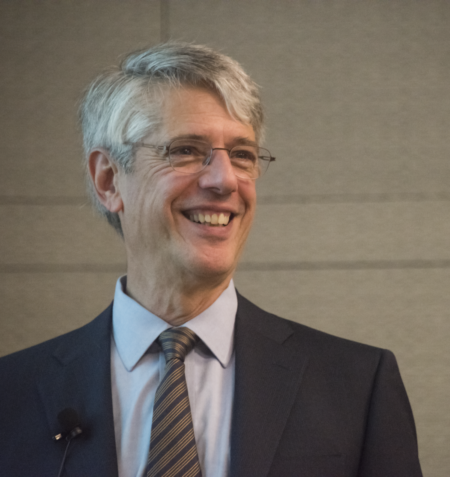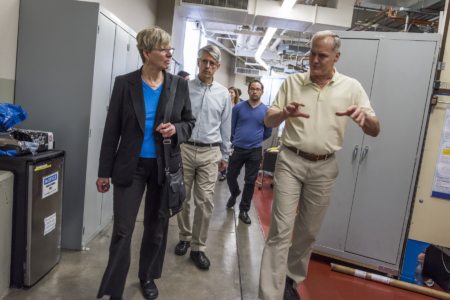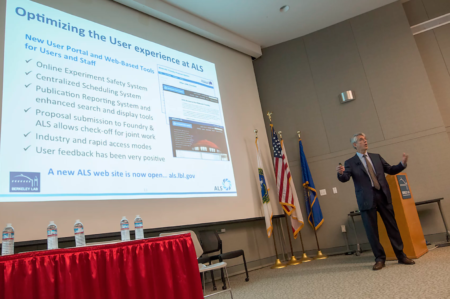 I want to thank everyone in the ALS family for an extremely productive and exciting 2016, and convey my expectations for our continuing successes in 2017. We have much to be proud of as we continue to build our capabilities and collaborations, increase the impact of our scientific outputs, and expand our ability to enable important science for users in so many areas of research and development.
I want to thank everyone in the ALS family for an extremely productive and exciting 2016, and convey my expectations for our continuing successes in 2017. We have much to be proud of as we continue to build our capabilities and collaborations, increase the impact of our scientific outputs, and expand our ability to enable important science for users in so many areas of research and development.
It is important to start off with a reflection on working safely. At our recent ALS Safety Day, I offered three observations: (1) we should return home as healthy as when we came to work; (2) working safely enables better work and superior science; and (3) safety practices should be routine outside work, too.
While these are good guiding principles, I’ll offer another three concepts that I recently learned while attending a local volunteer program, called “Citizen’s Academy,” run by our police chief in Lafayette. In a class on traffic safety, officers stated three main causes of accidents, or as they are now called, incidents, because they could have been prevented. These made an impression on me, and I often consider them when driving or engaging in other activities that have some risk. The police said that accidents are mainly caused by a combination of: (1) inexperience; (2) inattention; and (3) in a hurry. (Inebriation somehow works into this too, but it’s less relevant for this message.) Those three items are easy to remember and are especially relevant if, for example, (1) we don’t yet have the appropriate training for a particular work activity, like working with reactive chemicals, or (2) we are being distracted, say by cell phones, or (3) we are rushing and cutting corners, because someone said they have a deadline. The solutions to acting more safely are usually obvious, as are the dire consequences of acting unsafely, if we stop to consider them. I hope that reflecting on these three causes of accidents is helpful for you, too.

The year 2017 means that it is time for our next Triennial Review (coming in March), an important assessment by our peers and Department of Energy program managers. I believe that we are very well prepared, with strong metrics (highest-ever number of users and publications), meaningful progress on projects, compelling stories of science and technology from our users, highlights of performance by our excellent staff, and a clear business model for how we utilize our funding.
For example, we can report that we brought the new MAESTRO beamline to commissioning and early experiments; the COSMIC undulator, beamlines, and instruments are being installed; and the parts for the AMBER and QERLIN beamlines are being ordered, helping us expand our work in the basic science that underlies energy technologies and novel quantum materials. Additionally, progress is continuing on the new structural biology beamline, GEMINI, funded by the Howard Hughes Medical Institute and industry. Progress is also being made on many other beamline upgrades, and we await funding for a host of new ideas. Importantly, we also have brought online our web-based portals, allowing users to better interact with us, staff to better plan, and safety to be ensured, all to a new level of clarity and effectiveness.
We are very grateful for our federal funding from taxpayers, but our ability to staff all of the scientific work we want to undertake for users is, of course, limited, and we are always looking for ways to be more efficient and help our staff reach a good balance between their work and life activities. While we have spoken about this in various venues, I want to continue to hear if you have ideas on how to better achieve this.
Additionally, we are always seeking ways to increase the diversity of our workforce, and while I feel we have solid programs for broad job searches, and the culture at ALS is inclusive, we can do better in reaching out and supporting a wider range of staff who have different experiences and backgrounds. While we are not growing our staff (due to funding levels that are flat, especially when inflation is taken into account), we are able to hire when someone leaves, e.g., upon retirement.

Our advisory groups, including the Science Advisory Committee and the Users’ Executive Committee, are, as always, helpful and evolving, and as we move forward with new projects, we need to interact with them even more. Our biggest new project is of course the ALS upgrade: ALS-U. This past fall we heard that the project received Critical Decision Zero, CD-0, which means DOE sees a need in their mission for what ALS-U promises: a highly coherent and powerful source of soft x-rays, together with many other advantages to our broad program of x-ray science. LBNL now has a special team focused on ALS-U, which is headed by Dave Robin and reports directly to our lab director, Mike Witherell. They are committed to moving this project along so that in the future we can provide users much brighter beams.
As you know, the level of funding for science from Congress is currently uncertain. While this impacts our ability to plan and implement great new ideas, I am quite confident that we have appropriately prioritized for potential scenarios, and we are prepared to move forward with our current plans. We keep in constant touch with our DOE program managers, and respond to requests from members and staff in Congress who are making larger choices on funding for science and for national lab facilities. I believe that large facilities at national laboratories are generally acknowledged to be both critical to the leadership role that our nation plays in science and technology and critical to economic growth in the longer term.
In summary, it was a very successful 2016, and I am looking forward to an exciting 2017!